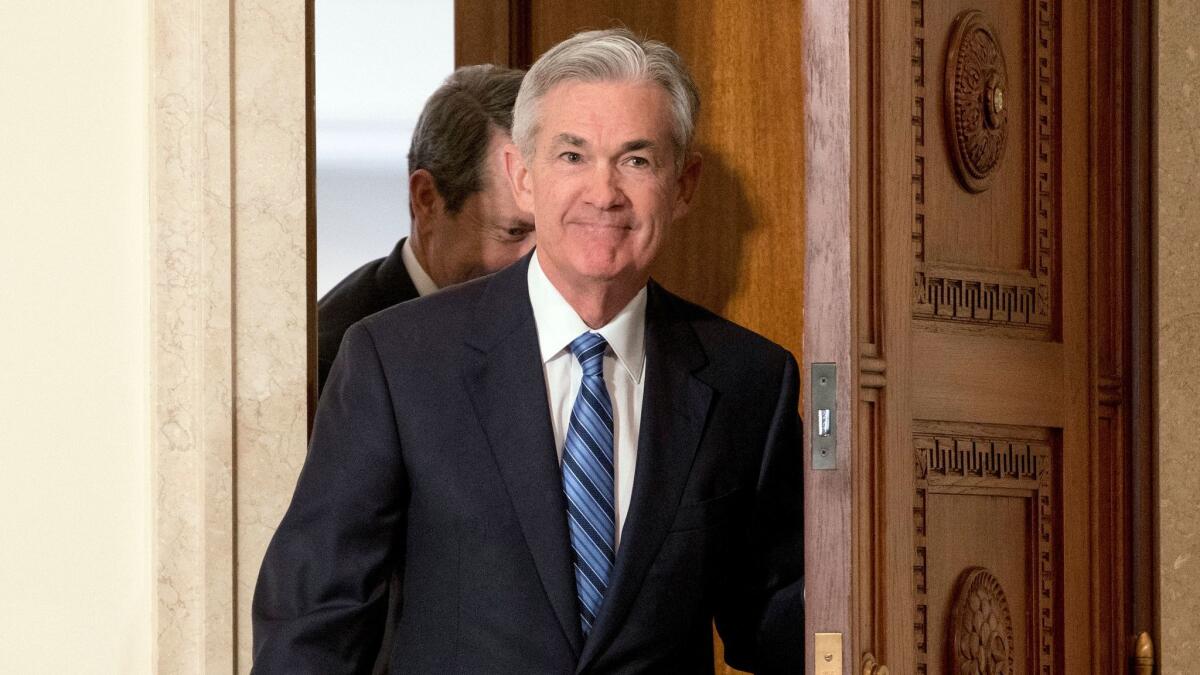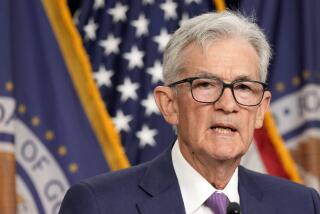Will the wild stock market cause the Federal Reserve to slow interest rate hikes? And should it?

Reporting from Washington — Financial markets delivered an unwelcome gift for Jerome H. Powell when he was sworn in last week as chairman of the Federal Reserve — a nosedive.
Triggered by fears of rising inflation and interest rates, the Dow Jones industrial average’s record 1,175-point plunge on Feb. 5 kicked off the worst week for stocks in two years. The steep market declines and nerve-rattling volatility put Powell and his colleagues in a bind.
The easiest way to calm investors would be for Fed policymakers to signal that they will slow their gradual interest rate hikes, including delaying the next small one expected in March. But that move could backfire, ultimately allowing the economy to overheat and forcing the Fed to raise rates more quickly.
So far, based on public comments of Fed officials, it doesn’t look like they plan on delaying a March rate hike — and some analysts even have suggested the pace could be accelerated to address fears of rising inflation fueled by the double-barrelled stimulus of Republican tax cuts and increased federal spending.
A key read on inflation comes Wednesday when the Labor Department releases the consumer price index for January. A big jump in prices would confirm Wall Street’s fears about rising inflation and could cause another sell-off as investors fear higher interest rates are coming.
But there are still five weeks and several key economic reports forthcoming, including a different measure of inflation the Fed prefers, until members of the central bank’s policymaking committee have to make a rate-hike decision.
Fed officials face a difficult task as they weigh the market volatility amid numerous signs of a strengthening economy.
“The Fed has to strike a delicate balance to say, ‘We’re going to make policy based on the economic data,’” said Lindsey M. Piegza, chief economist at brokerage firm Stifel Nicolaus & Co. “‘We’re not here to hand-hold nervous investors during times of volatility.’
”They can’t start catering to market whims,” she said.
As the markets have shown this month, a lot can happen in a short period of time.
“If stocks do not climb back closer to the year’s highs. I think … it will significantly lower the chance they will hike rates,” said Chris Rupkey, chief financial economist at MUFG Union Bank in New York. “It throws a monkey wrench into the Fed’s deliberations.”
The Fed has a dual mandate of maximizing employment and ensuring price stability. In effect, that means central bank officials try to use their benchmark short-term federal funds rate to keep unemployment low and inflation running at 2% a year.
But there’s an unwritten third mandate: financial stability. And that’s led the Fed to alter its plans in the past.
In September 2015, turbulent markets and a slowing Chinese economy caused Fed monetary policymakers to delay a long-awaited interest rate hike — the first since 2006 — even though then-Chairwoman Janet L. Yellen noted the economy’s fundamentals and outlook remained solid.
The Fed ended up hiking the rate a quarter of a percentage point three months later after markets had calmed.
Then twice in 2016, market gyrations led the Fed to signal it was taking a wait-and-see approach on additional rate hikes, first triggered by fears of slowing global growth and then because of uncertainty about the fallout from Britain’s vote on leaving the European Union.
The turmoil was short-lived and another 0.25-percentage-point hike was eventually approved in December 2016.
Powell cited the Fed’s financial stability role in public comments he made Tuesday at a second, ceremonial swearing-in event as Yellen’s replacement.
While he did not specifically mention the recent market volatility, Powell said “the challenges we face are always evolving” and pledged to “remain alert to any developing risks to financial stability.”
As other Fed officials have done during the past week, Powell gave an upbeat view of the economy in his brief remarks. He said the unemployment rate has declined significantly in recent years, the financial system “is incomparably stronger and safer” and “the global economy is recovering strongly for the first time in a decade.”
Powell noted the Fed has been gradually moving its monetary policy back to normal after taking extraordinary steps to fight the Great Recession.
The Fed raised the benchmark rate three times last year, bringing it to a range between 1.25% and 1.5%. That is still historically low but well above the near-zero level where the Fed had held it from late 2008 until the end of 2015 in an unprecedented attempt to stimulate growth.
Low interest rates are designed to spur spending by making it less enticing for businesses and consumers to save. For investors, low rates make stocks a more attractive option for obtaining a return.
Fed policymakers indicated in December they planned on three more small rate hikes this year. Investors have been betting that the first one will come after the Fed’s next meeting on March 20-21.
The market volatility hasn’t changed that view — yet.
The odds of a March rate hike were 77.5% on Tuesday, according to the FedWatch tool of the CME Group futures exchange. The figure actually was up from 70.5% a week earlier and 66.5% in January.
The continued strong belief in a March rate hike is probably based on recent comments from some voting members of the Fed’s rate-setting committee.
Last week, William Dudley, president of the Federal Reserve Bank of New York, called the recent market moves “small potatoes.” John Williams, president of the Federal Reserve Bank of San Francisco, said the market gyrations had not shaken his view that the “economy is on a very solid growth path.”
And on Tuesday, Loretta Mester, president of the Federal Reserve Bank of Cleveland, said she expected the economy “will work through this episode of market turbulence.”
“While a deeper and more persistent drop in equity markets could dash confidence and lead to a pullback in risk-taking and spending, the movements we have seen are far away from this scenario,” she said in a speech to the Chamber of Commerce in Dayton, Ohio.
Piegza said it’s good that the Fed’s policymaking committee, which last met at the end of January, doesn’t gather again until late March.
There will be more releases of economic data before then. They include the February jobs report, which will show whether last month’s jump in year-over-year average hourly earnings — an important factor in triggering the latest inflation fears — was the start of a trend or another false sign of stronger wage growth.
“I think this is going to buy them a little time to get a better sense of what’s happening with the consumer in the first quarter,” she said. “It gives them time to assess where inflation is headed and they can see how equity markets are doing.”
Rupkey said Fed officials have a tricky task trying to figure out how to factor stock market volatility into their deliberations.
“When it comes to the stock market,” he said, “they’re damned if they look at it and they’re damned if they don’t.”
Twitter: @JimPuzzanghera
More to Read
Inside the business of entertainment
The Wide Shot brings you news, analysis and insights on everything from streaming wars to production — and what it all means for the future.
You may occasionally receive promotional content from the Los Angeles Times.











